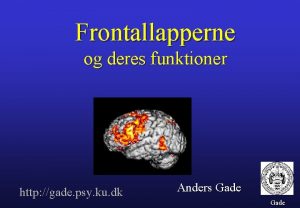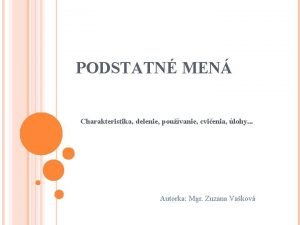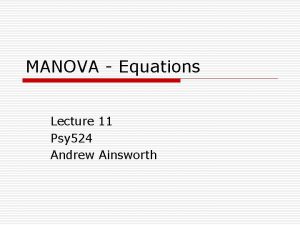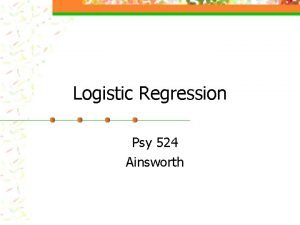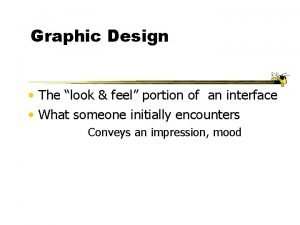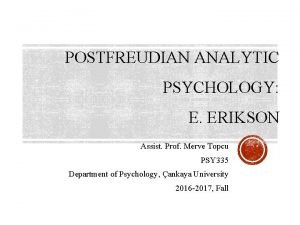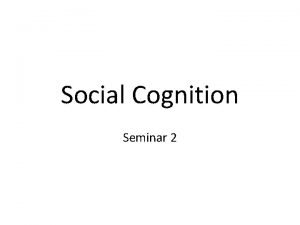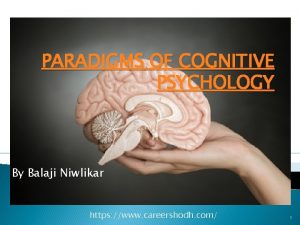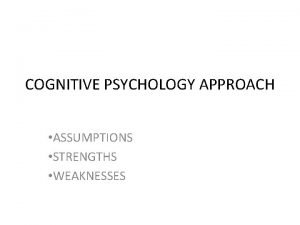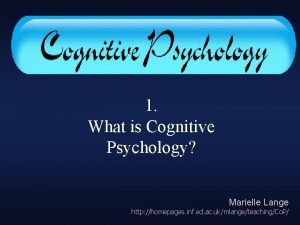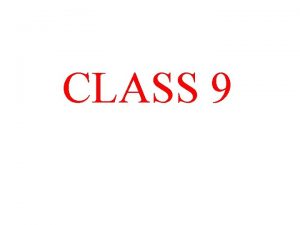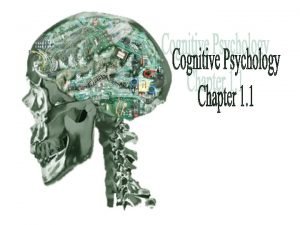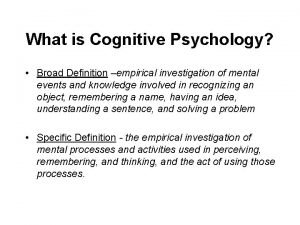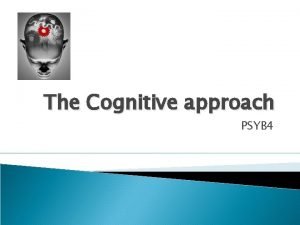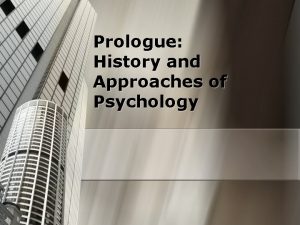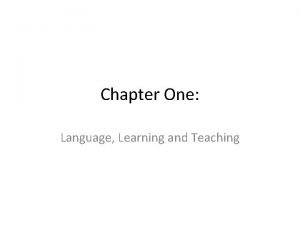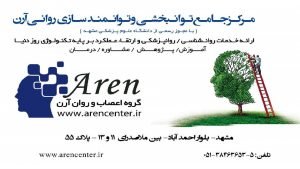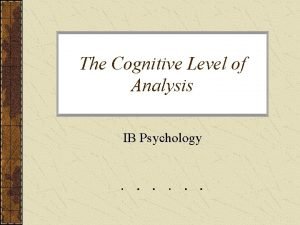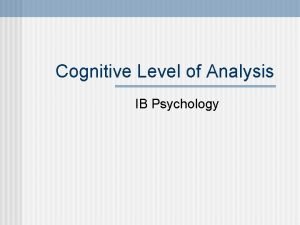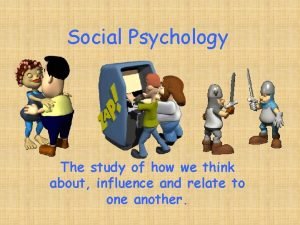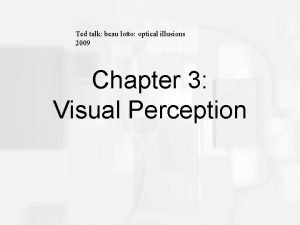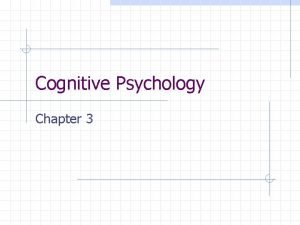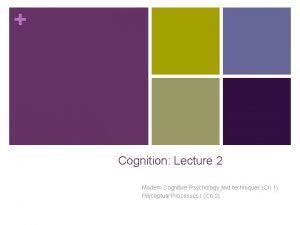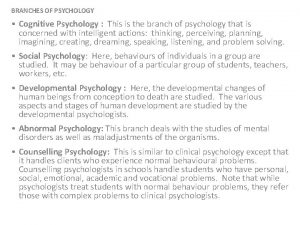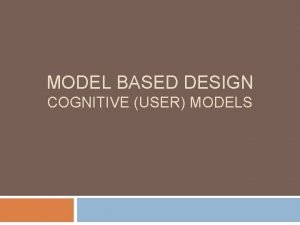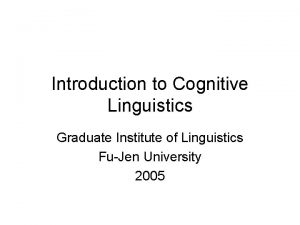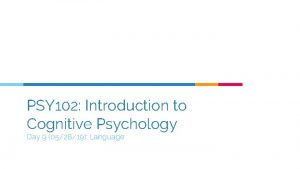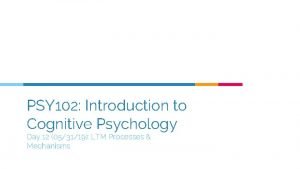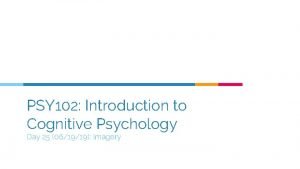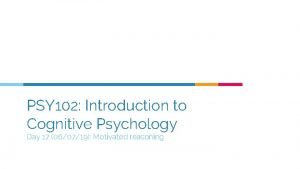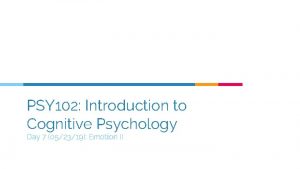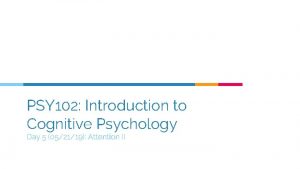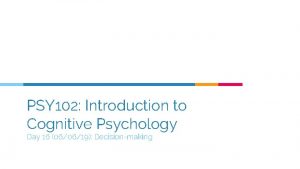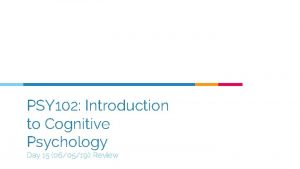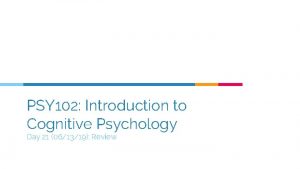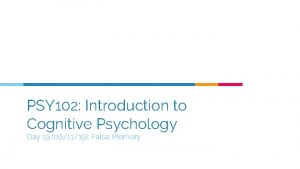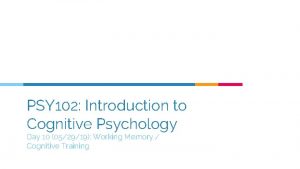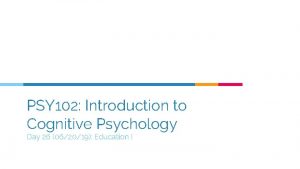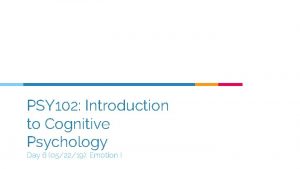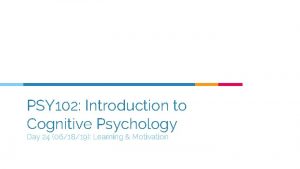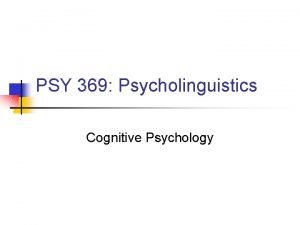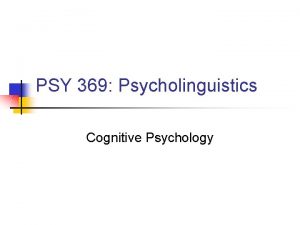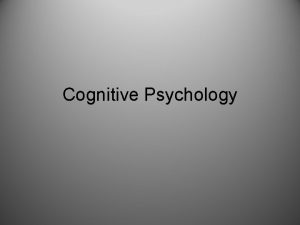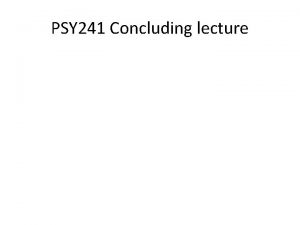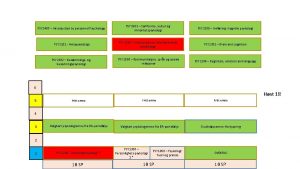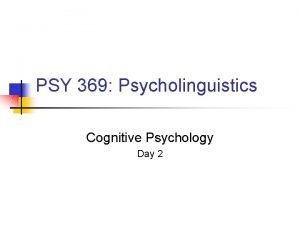PSY 102 Introduction to Cognitive Psychology Day 14






































































- Slides: 70

PSY 102: Introduction to Cognitive Psychology Day 14 (06/04/19): Knowledge / Categorization

Today’s Work + Agenda 1. LO 1: Continue to build a supportive classroom culture & discuss science communication ○ Peer feedback on opening science summary paragraphs ○ Tomorrow: will get back to the worksheet from yesterday on memory articles & tie all together 2. LO 2: Describe the basic fundamental principles of categorization & knowledge ○ Discussion of Chpt 9 in Goldstein book i. Compare and contrast the prototype and exemplar approaches to categorization ii. Compare and contrast the semantic category approach to the connectionist model of representing knowledge

Tomorrow’s Work Scientist Summaries: ▷ ▷ Hutter & Wilson (2018) -> category learning Frankland & Josselyn (2018) -> conditioning Ramirez (2018) -> consolidation of memories Just read 1; gives you an extra example of scientist summary, since you haven’t had as many Podcast: ▷ Looking Back from Hidden Brain ○ Can think of this in light of Stanley et al. (2017) (the counterfactuals, imagine memory worse/better) Wikipedia Biography (see Slides on Friday for guide) Midsemester Course Feedback - please!

Peer Feedback on Scientist Summary Continue to build a supportive classroom culture & discuss science communication

Peer Feedback Take the next minute or two to read through the opening paragraph of the person next to you. Then, take some time (~5 min) to discuss what could be improved and what was already strong in the paragraph.

Categorization & Knowledge Describe the basic fundamental principles of categorization & knowledge

Concepts & Categories ▷ Provide a means to organize and use your knowledge / semantic memory ▷ Helps us know things about an item ○ it’s a car, so it’s likely to need gas ▷ QOTD: How does the mind represent categories?

Inferences You Can Make

Definitional approach ▷ ▷ Necessary conditions (definition of category) Window ○ Rectangular, clear material, separates inside and outside of building, does not function as an entrance/exit under normal circumstances ○ What about a round window, stained glass window, or a window in front of a bank teller or clinic receptionist? What’s the problem? What about family resemblance ?

Demo: In 1 minute, list as many items as you can in the category “birds”. . .


Prototype approach ▷ ▷ How similar is an object to the most typical, average case? ○ Only one prototype per category ○ Does not need to be a real example What is your idea of a typical window? Rate how much an item matches category: ○ High prototypicality: close member-prototype match ○ Low prototypicality: not a close match Strong, positive relationship between prototypicality & family resemblance

Demo: Family Resemblance List as many characteristics and attributes as you can that you feel are common to these objects. ▷ Chair ▷ Sofa ▷ Mirror ▷ Telephone

Sentence verification Say “yes” if the statement is true and “no” if the statement is false.

An apple is a fruit.

A pomegranate is a fruit.

A tomato is a fruit.

Typicality Effect You’re faster to respond for objects that are high in prototypicality. ▷ Fastest for apple, then pomegranate, then tomato

Demo: Say “same” out loud if the color dots I present you with are of the same color and “different” if the dots differ in color.

blue


blue


Typicality Effect

Typicality Effect

In sum. . . Family Resemblance: High prototypical items rated higher as “good” members of categories (e. g. , ~ sofa/chair demo) Typicality: Respond faster/Categorize more quickly members that are “typical” of category (e. g. , fruit demo) Naming: Name high prototypical items first when thinking of category members (e. g. , bird demo) Priming: faster same-different color judgments for high prototypical items (e. g. , blue dots demo)

Let’s answer some MC. . .

Which of the following statements is NOT a reason why categories are useful? A. Categories provide definitions of groups of related objects B. Categories help us understand behaviors that we might otherwise find baffling C. Categories serve as a valuable tool for making inferences about things that belong to other categories D. Categories have been called “pointers to knowledge” because once you know an object’s category, you know a lot of general things about it.

The principle illustrated when most people are able to recognize a variety of examples of chairs even though no one category member may have all of the characteristic properties of “chairs” (e. g. , most chairs have four legs but not all do) is A. Family resemblance B. Prototypicality C. Graded membership D. Instance theory

The prototype approach to categorization states that a standard representation of a category is based on A. The definition of the category B. A universal set of category members C. A defined set of category members D. Category members that have been encountered in the past

A task for determining how prototypical an object is would be A. A fill-in-the-blank task where participants generate paired members within a category B. A task where participants rate the extent to which each member represents the category title C. A task where participants rate the extent to which category members resemble one another D. A fill-in-the-blank task where participants generate the category classification for a list of members

Exemplar approach ▷ ▷ ▷ How similar is an object to previous examples? ○ Multiple exemplars per category ○ Exemplars are real cases (not abstract averages) What are representative examples of different types of windows you have encountered? Test object ○ How well does it match any of those exemplars? Similarly… the more similar a specific exemplar to a known category member, the faster it’s categorized (family resemblance effect)

Exemplars ▷ Like prototypical categories, the question is “How much does X resemble” something ○ (Instead of “Does it meet every single criterion”) ▷ Instead of resembling a prototype, it’s resembling known category members ○ Exemplars

Using Different Approaches ▷ You encounter Item X. You want to see if it’s in Category Y. ▷ Which of these do we definitely not want to use and why? ○ Definitional approach? ○ Prototype approach? ○ Exemplar approach?

Using Different Approaches ▷ You encounter Item X. You want to see if it’s in Category Y. ▷ Which of these do we definitely not want to use and why? ○ Definitional approach? ○ Prototype approach? - “How closely does X resemble the prototypical Y? ” ○ Exemplar approach? - “How closely does X resemble a Y I’ve seen in the past? ”


Which do we use? ▷ Most likely both, but in different situations ▷ Prototype = large categories ▷ Exemplar = small categories ▷ Why?

Let’s Answer Some MC. . .

Not all of the members of everyday categories have the same features. Most fish have gills, fins, and scales. Sharks lack the feature of scales, yet they are still categorized as fish. This poses a problem for the ____ approach to categorization. A. Prototype B. Exemplar C. Definitional D. Family resemblance

Olin and Bob are neighbors. Olin loves birds and his father works for the zoo. He has been to a dozen bird sanctuaries, and he and his dad go on bird watching hikes once a month. In contrast, Bob doesn’t think much about birds. His only contact with them is in his backyard. It would be correct to say that Olin’s standard probably involves A. More prototypes than Bob’s B. More exemplars than Bob’s C. More prototypes and more exemplars than Bob’s D. The same prototypes and exemplars as Bob’s

Imagine that a young child is just learning about the category “dog. ” Thus far, she has experienced only two dogs, one a small poodle and the other a large German shepherd. On her third encounter with a dog, she will be LEAST likely to correctly categorize the animal as a dog if that animal A. Matches the size of the poodle but is of a different breed B. Is a dog that does not bark C. Matches an exemplar of one of the dogs she has experienced D. Is similar to an “average” for the dogs she has encountered

For the category ‘fruit, ’ people give a higher typicality rating to ‘banana’ than to ‘kiwi. ’ Knowing that, we can also reason that A. The word ‘fruit’ will lead to a larger priming effect for banana than for kiwi B. When people are asked to list all the fruits they can think of, kiwi will usually appear on their list before banana C. Neither kiwi nor banana are likely to be the fruit ‘closest’ to the prototype of the fruit category D. People will have a similar number of exemplars for kiwi and banana

How do we know how specific to get in our categorization? ▷ Vertebrates ○ Birds ■ Flamingo ■ Hawk ■ Blue-jay ■ Robin ■ Sparrow ■ Owl ■ Penguin

Hierarchical Organization of Categories ▷ ▷ Superordinate categories ○ Basic categories Specific (or subordinate) ▷ Furniture (Global) ○ Chairs ■ Armchairs ■ Dining room chairs ○ Tables (Basic) ■ Coffee table ■ Kitchen table (Subordinate / specific) ○ Beds ■ Queen-sized bed ■ Bunk beds

Basic = best ▷ ▷ Basic categories are the most psychologically important ○ It’s the label you are likely to assign an item that you see ○ You answer quickest to basic categories ○ RT for “Is this a pumpkin? ” < RT for “Is this a vegetable? ” or “Is this a small sugar pumpkin? ” Rosch (1976) asked subjects: ○ “How many things do all pieces of furniture have in common? ” ○ “How many things do all tables have in common? ” ○ “How many things do all kitchen tables have in common? ”

Table as the basic category



Kitchen table as the carpenter’s basic category - effect of expertise/familiarity

Let’s Answer Some MC. . .

Jumping from ____ categories results in the largest gain in information. A. Superordinate level to basic level B. Basic level to subordinate level C. Subordinate level to basic level D. Basic level to superordinate level

If we were conducting an experiment on the effect knowledge has on categorization, we might compare the results of expert and non-expert groups. Suppose we compose horticulturalists to people with little knowledge about plants. If we asked the groups to name, as specifically as possible, five different plants seen around campus, we would predict that the expert group would primarily label plants on the _____ level, while the non-expert group would primarily label plants on the _______ level. A. B. C. D. Superordinate; subordinate Superordinate; basic Subordinate; basic Basic; subordinate

Takeaways ▷ ▷ How do we decide what fits in a category? ○ Definition? (nope) ○ Prototype? (sometimes) ○ Exemplar? (sometimes) Hierarchy of categories ○ Global/superordinate > basic > specific/subordinate ○ Basic categories are “privileged” (psychologically important) ○ What counts as “basic” to you depends on your life history and situation ○ Basic = the point at which getting more specific stops adding that much more detail

Apply to Everyday Life? Aside from relation to research on emotion & language that we’ve discussed… (and memory systems). . .

Computational models for knowledge storing

Collins & Quillian, 1969: Semantic Network Approach ● ● ● Cognitive Economy Exceptions (e. g. , ostrich) Inheritance

Collins & Quillian, 1969: Semantic Network Approach

Collins & Quillian, 1969: Semantic Network Approach ▷ Is cognitive economy right? ○ RT for “A pig is a mammal” > RT for “A pig is an animal” ▷ Typicality effect ○ Less prototypical stuff should be slower to recognize as part of that category, but… ■ A canary is a bird > An ostrich is a bird

Connectionist Models ● ● ● Units Weights Knowledge rep

Connectionist Models 1. The representation of an item is distributed across a lot of units (sound familiar? ) 2. Similar concepts have similar representations 3. There are intermediate units (middle) which can allow us to have complicated representations on the other side (right) of the item (left) 4. Not only is the representation that codes for an item distributed across a lot of units, that representation is repeated across the network… 5. . So if you knock out any one part of the network, you don’t lose the whole concept a. “Graceful degradation” 6. The representation isn’t just made up of binary 1 s and 0 s – there are “connection weights” that differ 7. A network can be “trained” by having experiences over time, and those connection weights can be updated

The representation of an item is distributed across a lot of units

Similar concepts have similar representations

There are intermediate units (middle) which can allow us to have complicated representations on the other side (right) of the item (left)

Not only is the representation that codes for an item distributed across a lot of units, that representation is repeated across the network…

. . . So if you knock out any one part of the network, you don’t lose the whole concept

The representation isn’t made up of binary 1 s and 0 s – there are “connection weights” that differ

A network can be “trained” by having experiences over time, and those connection weights can be updated

Takeaways ▷ Collins & Quillian/Semantic Network approach ○ Reflects the hierarchical nature of categories ○ Puts shared attributes at the right nodes to make the most efficient design possible (cognitive economy) ○ But it doesn’t seem to always work ○ Typicality not explained ▷ Connectionist models ○ Know the attributes of a connectionist model ○ Can you create walk yourself through how one concept from this class works? Use memory as an example. ○ How does this model differ from the one above?

Today’s Work + Agenda 1. LO 1: Continue to build a supportive classroom culture & discuss science communication ○ Peer feedback on opening science summary paragraphs ○ Tomorrow: will get back to the worksheet from yesterday on memory articles & tie all together 2. LO 2: Describe the basic fundamental principles of categorization & knowledge ○ Discussion of Chpt 9 in Goldstein book i. Compare and contrast the prototype and exemplar approaches to categorization ii. Compare and contrast the semantic category approach to the connectionist model of representing knowledge

Participation + Minute Paper https: //tinyurl. com/PSY 102 Participation https: //tinyurl. com/PSY 102 Minute. Paper. June 4
 Day 1 day 2 day 3 day 4
Day 1 day 2 day 3 day 4 Day 1 day 2 day 817
Day 1 day 2 day 817 Cognitive and non cognitive religious language
Cognitive and non cognitive religious language Psychology 102 practice test
Psychology 102 practice test Euro psy
Euro psy Ucf io psychology
Ucf io psychology Psy2055
Psy2055 Psy 2055
Psy 2055 Psy2055
Psy2055 Psy
Psy Psy sanin
Psy sanin Psy
Psy Psy 421
Psy 421 Phonological loop
Phonological loop Psy
Psy Psy 226
Psy 226 When sam listens to his girlfriend susan in the restaurant
When sam listens to his girlfriend susan in the restaurant Psy academy
Psy academy Damasio
Damasio Psy walsh
Psy walsh Najlepsi polovnicky pes
Najlepsi polovnicky pes N g d a l i
N g d a l i 11 psy
11 psy Regression psy
Regression psy Psy
Psy Psy 335 purdue
Psy 335 purdue Csc 102 introduction to problem solving
Csc 102 introduction to problem solving Cognitive psychology concepts
Cognitive psychology concepts Careershodh
Careershodh Emphasis
Emphasis Overjustification effect
Overjustification effect Cognitive approach strengths
Cognitive approach strengths 5 major domains of psychology
5 major domains of psychology Cognitive economy psychology definition
Cognitive economy psychology definition Computer metaphor in cognitive psychology
Computer metaphor in cognitive psychology History of cognitive psychology
History of cognitive psychology History of cognitive psychology
History of cognitive psychology Attention psychology definition
Attention psychology definition Cognitive psychology essay
Cognitive psychology essay Cognitive psychology crash course
Cognitive psychology crash course Cognitive model psychology
Cognitive model psychology Structural linguistics and behavioral psychology
Structural linguistics and behavioral psychology Hamid zolfaghari
Hamid zolfaghari Dual processing model ib psychology
Dual processing model ib psychology Ib psychology cognitive level of analysis
Ib psychology cognitive level of analysis Cognitive dissonance ap psychology
Cognitive dissonance ap psychology Eclectic approach ap psychology
Eclectic approach ap psychology Visual pathways
Visual pathways Transduction cognitive psychology
Transduction cognitive psychology Bottom up processing example
Bottom up processing example Cognitive psychology branches
Cognitive psychology branches An introduction to model-based cognitive neuroscience
An introduction to model-based cognitive neuroscience Cognitive linguistics: an introduction
Cognitive linguistics: an introduction William beanes elementary school
William beanes elementary school Ocean apart day after day
Ocean apart day after day Day to day maintenance
Day to day maintenance As your room gets messier day by day, entropy is
As your room gets messier day by day, entropy is I don't know about tomorrow
I don't know about tomorrow Romeo and juliet timeline day by day
Romeo and juliet timeline day by day Growing day by day
Growing day by day Observation of seed germination day by day
Observation of seed germination day by day Day by day seed germination observation chart
Day by day seed germination observation chart Role of transpiration
Role of transpiration I live for jesus day after day
I live for jesus day after day Rising he justified freely forever
Rising he justified freely forever Day one day one noodle ss2
Day one day one noodle ss2 Dayone dayone noodles ss2
Dayone dayone noodles ss2 Positive psychology ap psychology definition
Positive psychology ap psychology definition Attribution theory
Attribution theory Fundamental attribution error ap psychology
Fundamental attribution error ap psychology Explain methods of psychology
Explain methods of psychology


















